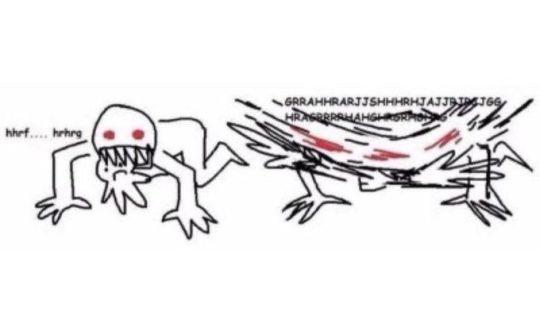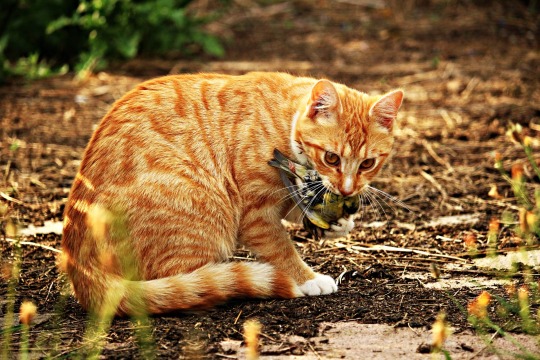#i dont remember the proper term that isn't just 'invasive-y' but yknow.
Text
The Secret Other Thing: KILL
This is my eighth post in a series I’ll be making on how to increase biodiversity on a budget! I’m not an expert--just an enthusiast--but I hope something you find here helps!

KILL, TEAR, RIP, MAIM.
You may have seen this sentiment a few times on gardening and wildlife blogs and been incredibly confused. Isn’t killing things the opposite of what you should be doing to protect habitats? In some cases, it really is necessary!
Invasive Plants
Invasive plants can do more harm than good, taking up space and nutrients and providing little in return to local wildlife--while spreading and choking out the native plants that would provide the most to our native fauna. Learn how to identify invasive species in your area and how to properly dispose of them, and do so whenever you have the opportunity! You may even be able to find volunteer groups/events where you can join up with like-minded people to remove a specific plant from an area.

(This image refers to the United States specifically--these plants aren't invasive or native everywhere!)
Pro tip, though; if you take out an invasive species and leave empty soil where it was, it’s likely another quick-growing invasive species will just move in. We don’t want that! Try to plant something in its place! If you’re going out on a mission to take out invasive plants, try to keep some native flower seeds or seedlings on your person while you do this work.
Different plants are invasive in different places, so be sure that the plant you're targeting is actually invasive to where you are. You don’t want to rip out a beneficial plant because it’s invasive somewhere else! Social media sites like Instagram and Tumblr are great for spreading information about invasive plants, but they can often be a bit… US-centric. Even I'm guilty of this, plenty of times! Plants like garlic mustard, kudzu, butterfly bush, Amur honeysuckle, wild radish, and Japanese knotweed are high-profile invasive plants that I hear about all the time here in America--but they came from somewhere, and are a part of the environment in these places! Likewise, many plants that are branded as pollinator-friendly and biodiversity boosters here in the states can be awful invasive species elsewhere. Even plants and animals that aren’t invasive in one part of a country or continent can be detrimental in another--Canadian waterweed is native to North America, but it’s actually invasive in Alaska.



(Japanese honeysuckle (Lonicera japonica) vs Coral honeysuckle (Lonicera sempervirens) vs the yellow variety of Coral honeysuckle (Lonicera sempervirens))
Be sure you’re taking out the right plant--be very confident in your ID before you take any action! Amur honeysuckle and Japanese honeysuckle, for example, may be invasive in the US--but coral and northern bush honeysuckles are native and key species in their environments. You don’t want to do harm while trying to do good--double check your IDs. Being certain with your IDs can also prevent you from doing harm to yourself and others--some plants produce toxic smoke when burned. Stay well-read on how to dispose of the invasive plants you’re targeting.

(Garlic mustard pesto! Can't say I've ever had it, but I've heard good things about it online!)
With that being said! Some invasive species can be eaten. It’s free food! And you’re helping the environment? Win-win! Try looking up recipes that use these plants, or see how you can substitute something else for them! Foraging guides and blogs would likely be extremely helpful for this.
A super easy way to help curb the spread of invasive plants is to not grow them yourself! Double check any plant you’re considering buying or growing from seed--some sold in stores like butterfly bush are often touted as great plants to add to a pollinator garden, but in reality are an invasive species that eagerly displaces native shrubs here in the states.

POV: you're working the garden center at the Blue Big Box Store, you care about the environment, and every day you watch people buy Butterfly Bush and can do jack shit about it asides from try to gently steer them towards something else (but the other next best option was also Invasive Tropical Milkweed because its easier for Big Box Store to sell) I have a personal vendetta against people who grow Butterfly Bush (I live in The States) (If you didn't know Butterfly Bush was invasive in the US before now you're valid but also please god consider replacing it with an alternative ASAP)
Invasive Animals

POV 30 to 50 feral hogs are running into your yard within 3-5 minutes while your small children play
Invasive animals and insects compete for resources, take over habitat, and can even spread disease--all while pushing native species out or dwindling their numbers. Keep track of invasive animals you see and report them. Depending on the severity of the situation, killing them can be necessary and even encouraged. Do be sure it’s an invasive species and not a look-alike. If you’re unsure, take pictures, do research, and take action the next time.
Some high-profile invasive species in the US are spotted lanternflies, cuban tree frogs, hammerhead worms, feral swine, zebra mussels, lionfish, asian carp, burmese python, and others. Again, do make sure you’re targeting species that are invasive in your area; I doubt Asian carp are considered invasive in Asia, for example. Similarly, the American bullfrog is native to the eastern US and Canada, but is quickly becoming an invasive species around the rest of the world. Not to mention, the racoon problem in Japan…

Some invasive species can be eaten as well! Some of them taste awful, and some can even be dangerous to eat or handle without caution. I would do a good amount of research online before trying to cook up just anything.
Doing it Right
If you’re trying to handle invasive species, you do have to ensure you’re doing it properly. As you do your research, you’ll likely see if the species should be photographed and reported and to what channels. Also in some cases, going about destroying them incorrectly could unintentionally help them spread--some plants spread quickly through rhizomes into disturbed soil, and hammerhead worms can actually regenerate from pieces into fully-developed new worms when you try to cut them up. Some invasive species are even actively harmful to humans, so I cannot emphasize enough that you need to be sure about what you’re dealing with and be careful about it. Giant Hogweed, for example, has toxic sap that’ll cause severe skin inflammation and painful blisters if it contacts skin and is exposed to sunlight. The blisters last for months, and the skin may develop long-term sensitivity for sunlight.
If you’re unsure about how to handle an invasive plant, or are unsure of it’s identity, try contacting your local university co-op extension service if you’re in the states. They can tell you how to remove it safely and effectively. I can't say for sure what other channels would be the best option for someone living outside the states, so if anyone knows, feel free to chime in!
Pets

POV: ur little outdoor kitty Firestar is destroying the balance of your local ecosystem plz keep him INSIDE
Please keep your pets inside, or at least on a leash. An outdoor cat can do a lot more damage than one might imagine, as well as unrestrained dogs.
That’s the end of this post! And... technically, the last post in the series! My next and final final post is gonna be basically a giant list of all my sources that I used to make this post! I hope this post series was informative, helpful, interesting--anything of value, really! Feel free to reply with any questions, your success stories, or anything you think I may have forgotten to add in!
#biodiversity#solarpunk#gardening#invasive species#ani rambles#out of queue#the biodiversity saga#i wasn't sure where to add this in on the post but not all non natives are invasive and some native plants have sorta invasive-y habits#i dont remember the proper term that isn't just 'invasive-y' but yknow.#with that being said I tend to do a quick google search to make sure a plant I wanna buy isn't invasive before I add it to my garden#with that being said fuck big box stores STOP SELLING INVASIVE PLANTS I SWEAR TO GOD I DONT CARE IF THEY'RE POPULAR STOP IT STOP IT STOP IT#someday I will go on an entire unhinged rant about tropical milkweed#ive already done it before but I'm willing to do it again fuck it#anyways!!!! this is the last post if you don't wanna read Collection Of Links: The Musical so uh#hope this was a nice series with helpful information!! love yall byeeee
58 notes
·
View notes